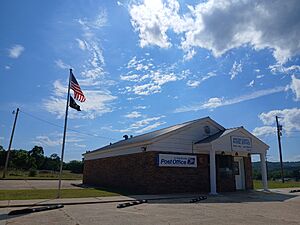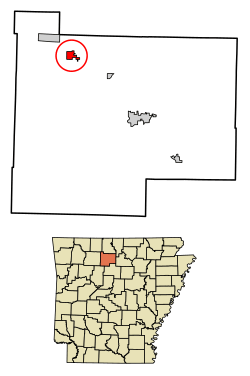St. Joe, Arkansas facts for kids
Quick facts for kids
St. Joe, Arkansas
|
|
|---|---|

St. Joe post office, July 2024
|
|

Location of St. Joe in Searcy County, Arkansas.
|
|
| Country | United States |
| State | Arkansas |
| County | Searcy |
| Area | |
| • Total | 1.25 sq mi (3.23 km2) |
| • Land | 1.24 sq mi (3.22 km2) |
| • Water | 0.01 sq mi (0.01 km2) |
| Elevation | 778 ft (237 m) |
| Population
(2020)
|
|
| • Total | 129 |
| • Density | 103.86/sq mi (40.11/km2) |
| Time zone | UTC-6 (Central (CST)) |
| • Summer (DST) | UTC-5 (CDT) |
| ZIP code |
72675
|
| Area code(s) | 870 |
| FIPS code | 05-62030 |
| GNIS feature ID | 2407269 |
St. Joe or Saint Joe is a small town located in Searcy County, Arkansas, in the United States. In 2020, about 129 people lived there. This town has a rich history, especially linked to mining and railroads. Today, it's known for its connection to the beautiful Buffalo River area.
Contents
Exploring St. Joe's Location
St. Joe is a town that covers a total area of about 3.2 square kilometers (1.25 square miles). All of this area is land.
Main Road Through St. Joe
The main road that goes through St. Joe is:
The Story of St. Joe: A Look Back
St. Joe was founded around 1860 by a group of people including Bill Campbell and Dr. George Turney. The first location of the town was near Mill Creek. Back then, people used wagon trains to travel to Springfield, Missouri. They would sell their farm products there and buy goods for the local stores.
From Monkey Run to St. Joe
Originally, the area was called Monkey Run. The name "St. Joe" came about around 1900. Six miners from St. Joseph, Missouri, received a lot of mail at the local post office. Because of this, the outpost became known as St. Joe, Arkansas.
Tales of Lost Silver Mines
Mines and stories about them are a big part of St. Joe's past. A nearby place is even called Silver Hill. One old story talks about a "Lost Silver Mine" that was supposedly very rich in the late 1800s. It was believed to be somewhere between Calf Creek and Bear Creek. An old newspaper article from 1924 even claimed the mine was found by a girl looking for a lost cow! However, historian James Johnson says that this "Lost Silver Mine" probably doesn't exist, even though the stories are fun to hear.
The Railroad Era
The railroad arrived in St. Joe in 1902 and was very important for the town. It helped ship mined ores from St. Joe. The old train station, called the Missouri and North Arkansas Railroad depot, has been restored. You can see it on U.S. Highway 65 in the middle of town today.
The St. Joe Lime and Crushed Rock Company also grew during this time. It operated a quarry just west of town. People say that St. Joe's lime and crushed limestone were known worldwide! The town was at its busiest during World War I, thanks to the mining industry.
A Bustling Town
During its busiest time, from 1917 to 1921, St. Joe had about 2,300 people. The town had four stores, two hotels (like the Henley Hotel, built around 1914), a blacksmith, a bank, mills, cafes, and a post office. The first school was a small log building that also served as a church.
When the price of zinc dropped after World War I, mining became too expensive. This also hurt the railroad, which relied on the mines. The town continued to be a place for selling farm products, cattle, cotton, and timber. But over time, the population and businesses slowly decreased. The railroad stopped operating in 1946.
St. Joe Today: A Community Spirit
Years later, the town decided to become an official town again. People wanted to have their own local government to help guide their community. Since then, the town has grown, adding over 100 acres.
Today, you can still see some of the old 1920s buildings. They stand alongside a gas station, the post office, and the St. Joe school. On the edges of town, there are a few motels and places to eat for tourists.
St. Joe might not be a big mining or farming center anymore, but it's proud of its history in the Ozarks. It's also seen as a gateway to popular outdoor areas along the Buffalo River. The town is working to bring back its pioneering spirit by restoring historic buildings and creating places like the Rural Help Center. This center helps the community with education and services.
Recent Community Efforts
- In 2011, St. Joe received a grant to help fix up the historic Missouri and North Arkansas Railroad depot.
- In 2012, the town launched a website to share its history and natural beauty, especially the Buffalo River.
- St. Joe is part of Ozark Byways, a group that promotes small towns in north central Arkansas.
- The Searcy County Rural Help Center opened in St. Joe in 2012. It's a non-profit run by volunteers. It offers computers, internet, and training to community members. They even have a "Kids Corner" open on Saturdays!
Education in St. Joe
St. Joe is part of the Ozark Mountain School District. This district operates St. Joe Elementary School. Students in high school attend Ozark Mountain High School. Before 2023, St. Joe had its own high school, but it joined with Ozark Mountain High School.
Population Changes Over Time
| Historical population | |||
|---|---|---|---|
| Census | Pop. | %± | |
| 1910 | 159 | — | |
| 1920 | 181 | 13.8% | |
| 1930 | 255 | 40.9% | |
| 2000 | 85 | — | |
| 2010 | 132 | 55.3% | |
| 2020 | 129 | −2.3% | |
| U.S. Decennial Census | |||
In 2000, there were 85 people living in St. Joe. Most people were White, with some Native American residents and people of two or more races. The town had 41 households, and about 24% of them had children under 18. The average age in St. Joe was 40 years old.
Famous People from St. Joe
- Ben C. Henley - He was a leader for the Republican party in Arkansas from 1955 to 1962. He was born in St. Joe.
- J. Smith Henley - He became a federal judge. He was also born in St. Joe.
See also
 In Spanish: Saint Joe (Arkansas) para niños
In Spanish: Saint Joe (Arkansas) para niños

